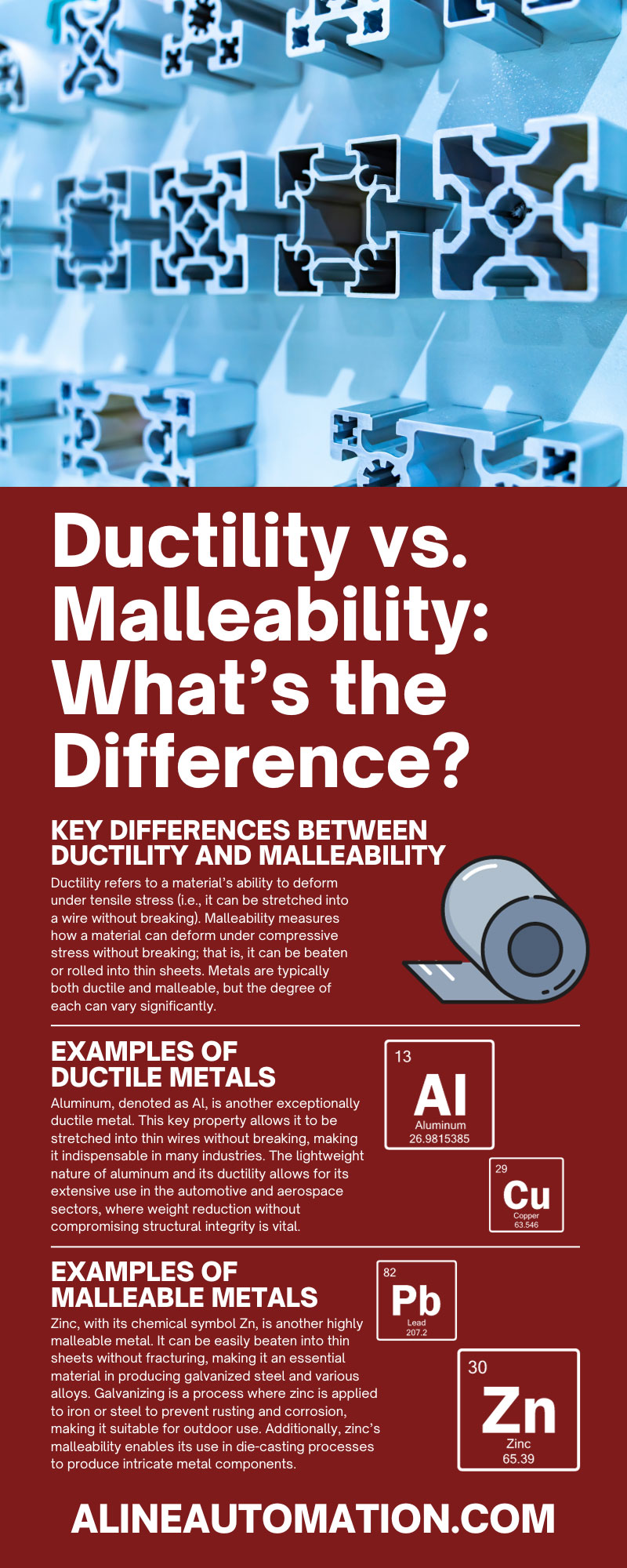
In material science, ductility and malleability are two key terms used to describe the mechanical properties of materials. Despite sometimes being used interchangeably, these terms have distinct definitions and implications.
Understanding the difference between ductility and malleability is crucial for engineers, metallurgists, and anyone involved in selecting or designing materials for various applications. Below, we’ll delve into the definitions of these terms and how they differ.
Ductility refers to a material’s ability to deform under tensile stress (i.e., it can be stretched into a wire without breaking). Malleability measures how a material can deform under compressive stress without breaking; that is, it can be beaten or rolled into thin sheets. Metals are typically both ductile and malleable, but the degree of each can vary significantly.
There are a few metals that are known for their high ductility. Let’s look at some examples:
Gold, often symbolized as Au from the Latin “aurum,” is renowned for its exceptional ductility. In its purest form, it can be drawn into extremely thin wires without losing its structural integrity. To illustrate, a single ounce of gold can be stretched into a gold thread over five miles without breaking. This malleability and ductility make gold ideal for intricate jewelry designs, electronics, and components where minute, precise forms are necessary. It’s worth noting, however, that gold’s ductility is often reduced in jewelry to improve its hardness and durability by alloying it with other metals.
Silver, with its chemical symbol Ag, is another highly ductile metal. It can be drawn into fine wires, allowing it to serve a key role in various industries. Its exceptional ductility enables the creation of microscopic electronic connections in semiconductor devices and integrated circuits. Furthermore, the ductility of silver makes it ideal for crafting intricate jewelry designs and silverware. However, like gold, silver is often alloyed with other metals to increase its hardness while retaining its ductility to a reasonable extent, thus expanding its application possibilities.
Copper, denoted as Cu, is another example of a highly ductile metal. Its ductility allows it to be drawn into very thin wires without breaking, making it an essential material in electrical wiring systems. The transmission of electrical energy is highly effective through copper because of its excellent electrical conductivity, second only to silver. However, copper’s ductility and electrical conductivity make it more suitable for electrical wiring, as it balances durability, cost effectiveness, and efficiency. Copper’s ductility also plays a significant role in plumbing, roofing, and industrial machinery, highlighting the metal’s versatility.
Aluminum, denoted as Al, is another exceptionally ductile metal. This key property allows it to be stretched into thin wires without breaking, making it indispensable in many industries. The lightweight nature of aluminum and its ductility allows for its extensive use in the automotive and aerospace sectors, where weight reduction without compromising structural integrity is vital. Aluminum’s ductility also comes into play in the packaging industry in the form of aluminum foil. The ability to withstand high levels of deformation without breaking highlights aluminum’s impressive ductility, widening its applicability range.
Let’s now look at some examples of malleable metals.
Lead, denoted as Pb from the Latin “plumbum,” is a classic example of a highly malleable metal. This soft and dense material can be easily flattened into thin sheets with minimal force, making it ideal for various applications. Its malleability comes into play in producing lead pipes for plumbing systems, stained glass windows, and as a key component in lead-acid batteries. However, because of its high toxicity levels, the use of lead is gradually being phased out in many industries.
Zinc, with its chemical symbol Zn, is another highly malleable metal. It can be easily beaten into thin sheets without fracturing, making it an essential material in producing galvanized steel and various alloys. Galvanizing is a process where zinc is applied to iron or steel to prevent rusting and corrosion, making it suitable for outdoor use. Additionally, zinc’s malleability enables its use in die-casting processes to produce intricate metal components.
Tin, denoted as Sn from its Latin name “stannum,” is another classic example of a highly malleable metal. It can be flattened into thin sheets without breaking, making it useful for various applications. Its malleability allows for the production of tin foil, which in the past was extensively used in cooking and food packaging because of its low reactivity with food products, though aluminum is much more commonly used in modern kitchen foils. Tin’s malleability also plays a significant role in the production of solder for electrical and plumbing purposes, as well as in the manufacture of tin cans used for food preservation.
In engineering and manufacturing, the ductility and malleability of materials significantly influence their application in different industries.
Ductile metals play a crucial role in industries where materials must be drawn into wires or undergo significant plastic deformation under tensile stress. As mentioned above, the electrical industry heavily relies on ductile metals like copper for wiring because the material can be stretched into thin wires without breaking. Similarly, the telecommunications industry also relies on ductile materials, such as gold and silver, to produce intricate electronic connections. The aerospace and automotive industries, favoring lightweight and ductile materials like aluminum, use them in manufacturing various components where weight reduction without compromising structural integrity is vital.
Malleable materials, on the other hand, find extensive use in industries where materials are required to be hammered or rolled into sheets. One such industry is the construction sector, where lead, known for its high malleability, is used in producing pipes, though its use is decreasing due to its toxicity. Because of its low reactivity with food products, the food industry utilizes malleable metals like tin for making tin foil and cans. In the manufacturing industry, zinc’s malleability is highly valued in the die-casting process for producing intricate metal components and galvanizing steel to increase its resistance to rust and corrosion.
Understanding the distinct properties of ductility and malleability is essential in material science, engineering, and various manufacturing industries. Although ductility and malleability describe the ability of a material to deform without breaking, their applications differ based on the type of stress a material can withstand. Use the information provided here to make informed decisions when selecting materials for different applications.
If you need aluminum connectors for your next project, A-Line Automation has you covered. With our state-of-the-art manufacturing processes and exceptional quality control, we can provide high-quality aluminum connectors that meet your specifications. Contact us today to learn more about our products and services!
